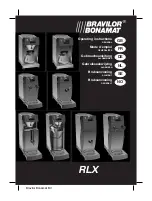
Rev. 4/6/2018
FORK-P MANUAL
Copyright 2018 Vestil Manufacturing Corp. Page 2 of 4
SIGNAL WORDS
This manual uses SIGNAL WORDS to indicate the likelihood of personal injuries, as well as the
probable seriousness of those injuries, if the product is misused in the ways described. Other signal
words call attention to uses of the product likely cause property damage. The signal words used appear
below along with the meaning of each word.
Identifies a hazardous situation which, if not avoided, WILL result in DEATH or
SERIOUS INJURY. Use of this signal word is limited to the most extreme situations
.
Identifies a hazardous situation which, if not avoided, COULD result in DEATH or
SERIOUS INJURY.
Indicates a hazardous situation which, if not avoided, COULD result in MINOR or
MODERATE injury.
Identifies practices likely to result in product/property damage, such as operation that
might damage the product.
HAZARDS OF IMPROPER USE
We strive to identify all foreseeable hazards associated with the use of our products. However, no
manual can address every risk. The most effective means for avoiding injury is to exercise sound
judgment whenever using this cart.
Improper or careless operation might result in serious personal injuries.
DO NOT exceed the 400 lb. (181.8 kg) capacity. Capacity is the maximum load the product can lift.
The lifting equipment (crane, hoist, trolley) must have AT LEAST the same capacity as this fork lifter.).
DO NOT attempt to lift any load whose weight exceeds the maximum rated load of the lifting component
(crane, trolley, hoist, FORK-P, etc.) with the smallest capacity. For example, if the crane, hoist and
FORK-P each have capacities of 400 pounds, but the trolley has a capacity of 100 pounds, the net
weight applied to the trolley must not exceed 100 pounds.
DO NOT use the fork lifter if any part of it is severely worn or damaged.
ALWAYS inspect the unit before each use according to the inspection procedures described in the
most recent revision of ASME standard B30.20.
Review the safety messages included in the manuals for your crane, trolley, hoist, and any other
device used in conjunction with the fork lifter.
Be certain that the fork moved with this device is properly attached to the forklift carriage before
disconnecting the fork from the lifter.
ALWAYS attach the lifter to a safety hook (e.g. a hoist hook that has a self-closing latch across the
throat opening of the hook) or to a connection that includes safety mechanisms to prevent accidental or
unintended detachment. DO NOT attach the lifter to a safety hook that does not function properly.
Attach the hoist hook to the appropriate lifting eye. The fork blade should be close to horizontal or tip
slightly towards the toe when the fork is suspended. (See “Using the Lifter” on p. 3).
Always test the connection between the lifter and the fork before raising the fork. Tighten both
knobs/tine locks against the blade of the fork. Confirm that the fork cannot slide out of the fork channel.
Only use the lifter to move a fork if the connection is secure.
DO NOT raise the loaded lifter over your feet or any other part of your body. Every person not involved
with lifting the fork should remain outside the lifting area for the duration of the process.
Avoid load swing. Before raising the fork, the hoist chain should be vertical, i.e. not angled. Slowly
raise the fork. Maintain control as the fork and lifter are raised.
Proper use, maintenance, and storage are essential for this product to function properly.
o
Always use this product in accordance with the instructions in this manual and consistent with any
training relevant to machines, devices, etc. used in conjunction with this product.
o
Keep the product clean & dry.






















